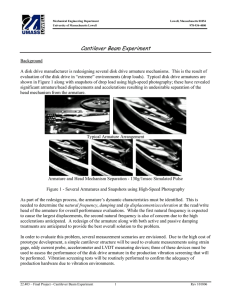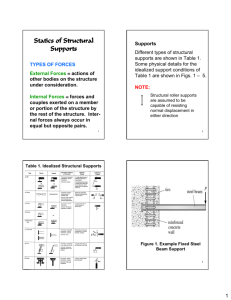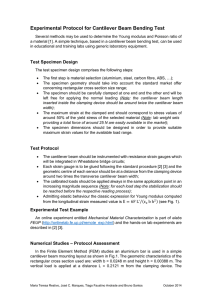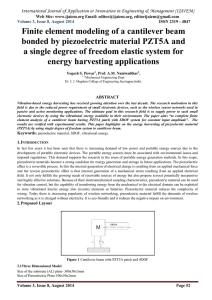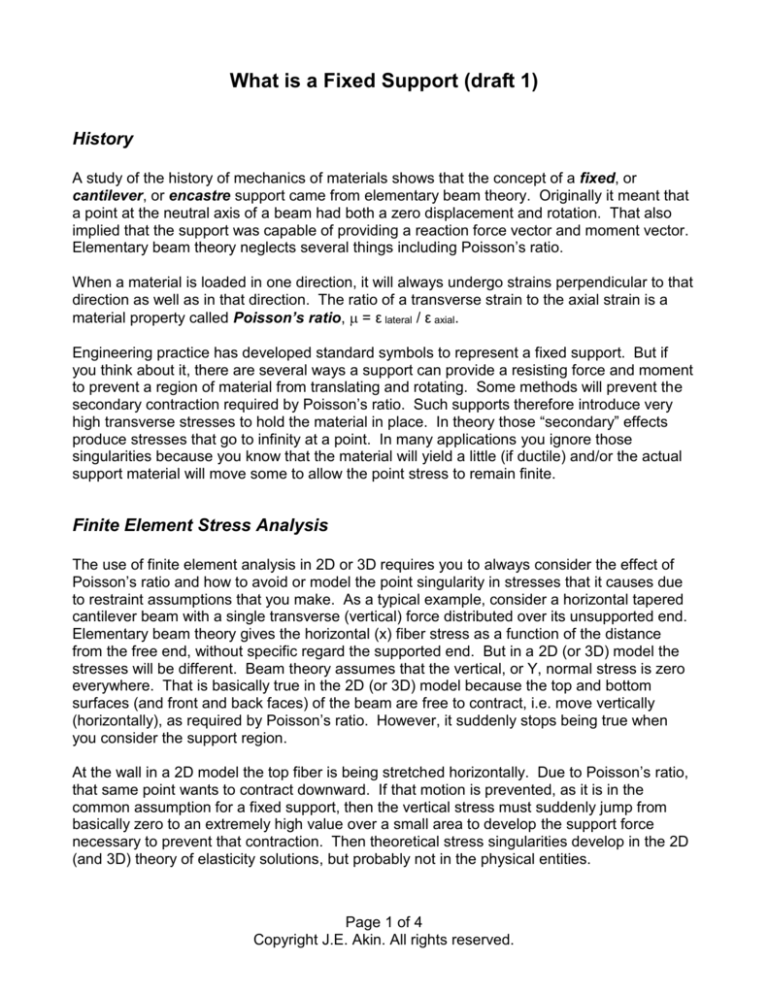
What is a Fixed Support (draft 1)
History
A study of the history of mechanics of materials shows that the concept of a fixed, or
cantilever, or encastre support came from elementary beam theory. Originally it meant that
a point at the neutral axis of a beam had both a zero displacement and rotation. That also
implied that the support was capable of providing a reaction force vector and moment vector.
Elementary beam theory neglects several things including Poisson’s ratio.
When a material is loaded in one direction, it will always undergo strains perpendicular to that
direction as well as in that direction. The ratio of a transverse strain to the axial strain is a
material property called Poisson’s ratio, = ε lateral / ε axial.
Engineering practice has developed standard symbols to represent a fixed support. But if
you think about it, there are several ways a support can provide a resisting force and moment
to prevent a region of material from translating and rotating. Some methods will prevent the
secondary contraction required by Poisson’s ratio. Such supports therefore introduce very
high transverse stresses to hold the material in place. In theory those “secondary” effects
produce stresses that go to infinity at a point. In many applications you ignore those
singularities because you know that the material will yield a little (if ductile) and/or the actual
support material will move some to allow the point stress to remain finite.
Finite Element Stress Analysis
The use of finite element analysis in 2D or 3D requires you to always consider the effect of
Poisson’s ratio and how to avoid or model the point singularity in stresses that it causes due
to restraint assumptions that you make. As a typical example, consider a horizontal tapered
cantilever beam with a single transverse (vertical) force distributed over its unsupported end.
Elementary beam theory gives the horizontal (x) fiber stress as a function of the distance
from the free end, without specific regard the supported end. But in a 2D (or 3D) model the
stresses will be different. Beam theory assumes that the vertical, or Y, normal stress is zero
everywhere. That is basically true in the 2D (or 3D) model because the top and bottom
surfaces (and front and back faces) of the beam are free to contract, i.e. move vertically
(horizontally), as required by Poisson’s ratio. However, it suddenly stops being true when
you consider the support region.
At the wall in a 2D model the top fiber is being stretched horizontally. Due to Poisson’s ratio,
that same point wants to contract downward. If that motion is prevented, as it is in the
common assumption for a fixed support, then the vertical stress must suddenly jump from
basically zero to an extremely high value over a small area to develop the support force
necessary to prevent that contraction. Then theoretical stress singularities develop in the 2D
(and 3D) theory of elasticity solutions, but probably not in the physical entities.
Page 1 of 4
Copyright J.E. Akin. All rights reserved.
Exercise modeling choices
With finite element models you are no longer restricted to using a handful of standard
symbols to represent a fixed support (or any other of the “stand” support types). You can
examine the actual application and extend the solid model to include your knowledge of the
actual support conditions.
For the cantilever example, assume it is steel and you know it will be welded to a much larger
steel vertical member. Saint-Venant’s principle, from the theory of elasticity, basically says
that the statically equivalent forces or supports occurring a few “typical dimensions” away on
an object will not affect results in the main regions of the object. Therefore, consider a finite
element model where the classic “fixed” support is replaced by a semi-circular region of the
vertical steel member. Pick its radius as the depth of the cantilever, and fix (in the classical
sense) the outer half circle. That will be statically equivalent to the standard symbol but will
produce more realistic stresses near the support region.
Example Cantilever
Page 2 of 4
Copyright J.E. Akin. All rights reserved.
Page 3 of 4
Copyright J.E. Akin. All rights reserved.
Page 4 of 4
Copyright J.E. Akin. All rights reserved.









